Unraveling the Mysteries of the Oceans: An Exploration of the Deep Blue Enigmas
The world’s oceans cover over 70% of the Earth’s surface, yet they remain largely unexplored and shrouded in mystery. Beneath the waves lie vast expanses of uncharted territory, teeming with life and enigmatic phenomena. From hidden creatures and ancient civilizations to unexplained natural occurrences, the mysteries of the oceans continue to captivate the human imagination. In this article, we embark on an intriguing journey into the depths of the oceans, delving into some of the most compelling mysteries that have eluded our understanding.

1. The Deep Sea: The Uncharted Abyss
The deep sea, comprising the ocean depths below 200 meters (656 feet), is one of the least explored regions on Earth. This dark and cold environment is characterized by high pressure and extreme conditions that pose significant challenges for human exploration.
Only a fraction of the deep sea has been explored, leaving vast areas uncharted and mysterious. Scientists believe that this realm holds countless undiscovered species, some of which may offer insights into the origins of life on Earth and the potential for life on other planets.
New technologies, such as remotely operated vehicles (ROVs) and autonomous underwater vehicles (AUVs), are enabling scientists to venture deeper into the ocean and shed light on its secrets. As exploration continues, the mysteries of the deep sea gradually unfold, revealing an incredible diversity of life and geological wonders.
2. Underwater Volcanoes and Hydrothermal Vents: Life in Extreme Environments
Underwater volcanoes, also known as seamounts, are among the ocean’s most intriguing geological features. These submerged volcanic mountains dot the ocean floor, yet their sheer numbers and the life they support remain largely unknown.
One of the most captivating discoveries associated with underwater volcanoes is hydrothermal vents. These are fissures in the Earth’s crust from which geothermally heated water, rich in minerals and chemicals, spews out. Despite the extreme conditions, hydrothermal vents harbor thriving ecosystems supported by chemosynthetic bacteria, which form the base of the food chain.
The study of underwater volcanoes and hydrothermal vents offers valuable insights into the adaptability of life and the potential for life beyond Earth in similarly extreme environments.
3. The Ocean’s Giants: Unraveling Marine Mammals’ Secrets
Marine mammals, such as whales, dolphins, and seals, are some of the ocean’s most awe-inspiring creatures. Despite their impressive size and social behaviors, many aspects of their lives remain a mystery to scientists.
One enduring enigma is the complex communication and vocalization of whales and dolphins. Researchers are continuously studying the meaning and patterns of their calls to decipher the intricate social structures and behaviors of these intelligent animals.
Moreover, the migratory patterns of some marine mammals, particularly whales, have puzzled scientists for years. How do they navigate across vast ocean expanses with remarkable precision, returning to the same feeding and breeding grounds year after year?
Understanding the lives of marine mammals is not only crucial for their conservation but also offers valuable insights into the interconnectedness of marine ecosystems and the health of the oceans.
4. The Bioluminescent Spectacle: Glowing Oceans
Bioluminescence, the production and emission of light by living organisms, is one of nature’s most mesmerizing spectacles. Many marine organisms, from tiny plankton to deep-sea creatures, possess the ability to produce bioluminescent light.
Bioluminescence serves various purposes, including attracting mates, deterring predators, and luring prey. The ethereal blue glow of bioluminescence creates a breathtaking display of nature’s beauty and complexity.
While scientists have made significant progress in understanding the mechanisms behind bioluminescence, there are still many species and behaviors that remain undiscovered and continue to intrigue researchers.
5. The Lost Civilizations: Sunken Secrets
The oceans hold a wealth of human history, with countless shipwrecks and submerged ancient civilizations waiting to be discovered. From ancient trading routes and lost cities to centuries-old shipwrecks, these underwater archaeological sites offer glimpses into the past and potential answers to historical mysteries.
Archaeologists and divers continue to unearth ancient artifacts and submerged ruins, such as the submerged city of Pavlopetri off the coast of Greece and the sunken city of Dwarka off the Indian coast. These discoveries provide invaluable insights into the history of human civilization and the impact of sea level changes throughout the ages.
6. Rogue Waves: The Enigma of Giant Walls of Water
Rogue waves, also known as freak waves or monster waves, are towering walls of water that appear unexpectedly in the open ocean. These massive waves, some reaching heights of over 100 feet, can be catastrophic for ships and pose a significant danger to maritime navigation.
The phenomenon of rogue waves has long puzzled scientists and mariners. While some are caused by the interaction of different wave systems, others seem to arise from unknown and unpredictable factors.
Understanding the origins and behavior of rogue waves is essential for improving maritime safety and predicting extreme weather conditions.
7. The Great Pacific Garbage Patch: A Growing Environmental Crisis
The Great Pacific Garbage Patch is a vast area in the North Pacific Ocean, characterized by a high concentration of floating plastic debris. This massive accumulation of plastic waste poses a significant threat to marine life and ecosystems.
The origins and dynamics of the Great Pacific Garbage Patch are complex and not fully understood. The patch comprises large and small pieces of plastic debris, including microplastics, which are tiny particles that can be ingested by marine organisms and enter the food chain.
Addressing the problem of ocean plastic pollution requires collective efforts, from reducing single-use plastics to implementing effective waste management and cleanup





Comments
There are no comments for this story
Be the first to respond and start the conversation.